Latest Posts by sparklypuppy05 - Page 2
So I had an idea for a thing:
I remember @sensoryseeker used to do something called Stim Toy Saturdays where folks would submit pictures of their favourite stim toys, but that was several years ago by this point. I want to start up something similar to that again, because seeing other people’s stim toys is awesome and great for discovering new ways to stim! Would anyone be interested if I revived Stim Toy Saturdays? I would probably choose a different day though (Stim Toy Tuesday maybe?), but yeah, let me know if there is interest and I will set something up!!!
(Edit: all replies will be trough my main, which is ‘montrealite’)
So the only all-bird rehab center in North Texas is about to shut down

I can’t even put into words how upset I am about this. Rogers Wildlife Rehabilitation has been open for almost twenty years, and is the only place in North Texas that takes in literally any type of bird if it’s been injured, orphaned, or otherwise incapacitated. They’re finally out of funds, and if they can’t come up with anything by April 2nd, they’re going to be forced to close their doors.
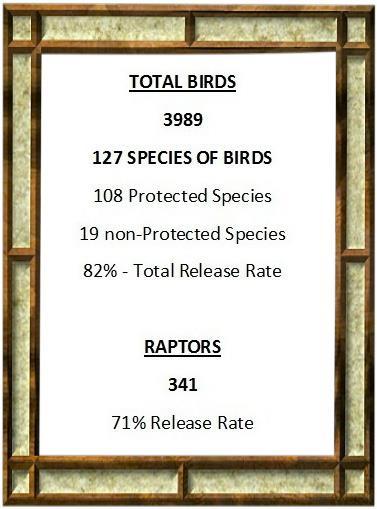
They’ve never turned away birds. Not when it’s a surprise 200 baby cattle egrets that’ve been orphaned because city planners thought they could cut down their homes and no one would notice. Not when it’s raptors with one good eye and in need of seven different antibiotics. Not even when it’s ducks that irresponsible parents won’t let their kids keep after easter. This is where anyone let me first get up close to birds. I mean, I’ve known I wanted to work with birds and wildlife since I was seven- I’m twenty four now, and halfway through an environmental science master’s and it’s a big reason I kept going.
I’ve been going to this place on and off for ten years, I was THIRTEEN when I started volunteering and seeing all the terrible things that happen to the birds that come in. Not just…hit by trucks, or caught in a hailstorm but parrots that have been left in foreclosed houses for weeks, and roosters that have come out of cock fighting rings and would otherwise be put down because the SPCA and humane societies don’t think they’re salvageable. There’s an emu that was raised there as a baby because no one wanted her. Her name’s Riley and I can’t even begin to comprehend what shutting the doors to the center would mean?


They don’t get government aid. They’ve been funded by the public donating and Kathy, the lady who owns the place, going through her retirement funds and savings and her social security to keep it running. She’s finally run out of money. Please, just reblog? Even if you can’t donate anything- and I know it’s a lot to ask for poor teenage/college kids to donate money that they don’t have, or struggling artists I know but maybe someone who can spare something will see it eventually? They need $200,000 to keep open for a year to continue to help 4000 birds a year.
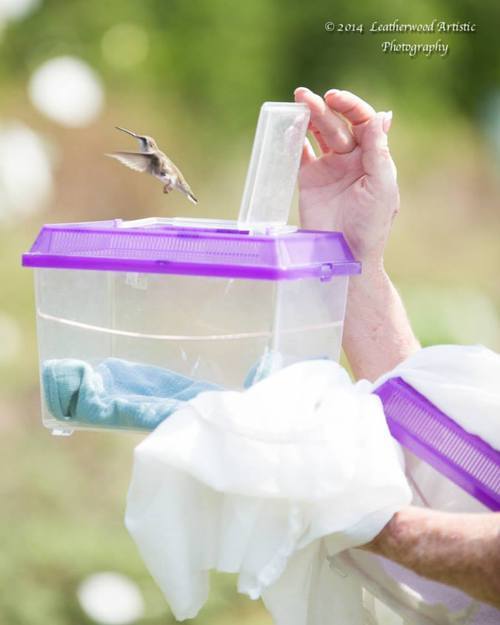
Just, thanks for reading, guys. Here’s the gofundme link: http://www.gofundme.com/l8aj7k
Their facebook: https://www.facebook.com/pages/Rogers-Wildlife-Rehabilitation-Center/398035120217303
Here’s their website: http://www.rogerswildlife.org/about.html
• Use the hand you write with.
• Make a fist with your thumb outside, not tucked inside. If it’s tucked inside your fist, when you punch someone, you might break your thumb. The thumb goes across your fingers, not on the side.
• Don’t be like in the movies—don’t aim for the face. Face punches don’t usually stop people, and you can miss when they duck their head or break your hand on their jaw. If you want to get away quickly, or end a fight, aim for the chest, or the ribs. If you really want to do some damage, e.g., you’re being attacked, aim for the throat, which will make it hard for your attacker to breathe for a hot minute.
• When you punch, you want to aim and hit with your first two knuckles. Not the flats of your fingers, and not your ring or pinky knuckles, which can break more easily. You can use your weight, if you’re on your feet, to add wallop, and spring into a punch with your feet and torso.
Modern Torchwood
So like imagine Torchwood but in 2018 where the team like to make memes of each alien they find and see who can make the best one.
Or the team bringing Jack along with them to a pride parade because he’d never been to one before as they never had them in the 51st century. (Plus decorating the hub with bisexual flags during pride month!)
Tosh and Ianto creating an alien spotting website whilst they’re drunk but the pictures are dubbed ‘too realistic’ and no one believes them.
Owen sometimes texting the Torchwood group chat in entirely emojis just because he can and because Tosh secretly finds it cute.
Tosh and Ianto having multiple conversations on different message apps whilst still managing to get work done to the others dismay.
‘Torchwood outside the government, beyond the police and without decent signal seriously who thought an underground base was a good idea?’
The team actually communicating and opening up with each other so they can work better together and get to know each other as friends not just work colleagues!!!
Gwen coming up with the ship names Janto and Towen and always trying to set them up together so she can finally take them all on a triple date with her and Rhys.
POSITIVE BISEXUAL REPRESENTATION WHERE THEY ACTUALLY TALK ABOUT THEIR SEXUALITIES 💗💜💙
Owen having a secret Instagram page for all his plants because they’re his children and they all have names and deserve love too!
I just miss Torchwood :(

This is the money pentacle. Reblog and unexpected money will come to you!
Basic Homesteading Skills
Crafts
quilting
embroidery
cross-stitch
knitting
crochet
sewing
Cooking and Baking
homemade bread
homemade butter
homemade extracts
dandelion jelly
Canning
26 canning recipes
canning jars 101
60 canning recipes
Gardening
edible trees to plant
what to plant to save the bees
cure and braid garlic
save seeds for next year
braid onions for long term storage
build a greenhouse
Animals
homemade chicken feed
raising mealworms for chickens
why to raise nigerian dwarf goats
Outdoors
starting a fire with sticks
trail signs
knotting
find true north without a compass
Medicine
homemade neosporin
all purpose healing salve
RIGHT. So. I just noticed something, and I have nowhere else suitable to put my opinion, so... here.
Society glamourizes alcohol/drinking far too much, really???
I was just looking at Mother’s Day cards (I know, I know) and I noticed that a good portion of them - at least half - involve alcohol, drinking, or wine in some way. It’s honestly a little disturbing. Alcohol is literally poison. Getting drunk is the effect of getting poisoned. Millions of people get addicted to alcohol/die from alcohol addiction every year, and even more have their lives disrupted from the addiction or death from alcohol poisoning of a friend or family member. Drunk driving is one of the leading causes of death whilst in a vehicle. Alcohol causes all sorts of diseases and health effects. All of this happens, and we’re encouraging our mothers, our fathers, our children, our siblings, and our peers to drink alcohol... for what?
Drinking doesn’t have a practical use. So, for what?
Fun?
Alcohol, a literal poison, is legal in almost every country, whilst weed/marijuana, a completely harmless plant, is still widely criminalised. The general population of many countries are drinking alcohol, getting themselves addicted, and draining their funds dry on alcohol, all on the reg, because they’re so bored that literally poisoning themselves seems like fun. And society lets it go on, unchecked, because that’s the way it’s always been. It’s time that something changed.
I’m not saying that moderate drinking if you like the taste of alcohol is a bad thing. If you legitimately enjoy the taste of alcohol, drink in small amounts. That’s fine. But if that’s not the case, please change.
If you’re a parent drinking because of your kids, don’t. Learn to discipline them properly, and that kids are noisy and messy and imperfect.
If you’re going out to bars or pubs every night for fun, don’t. Get a hobby, or start a new project. Even just sitting in front of the TV is better than drinking.
If you’re addicted, or think you might be... seek help. Go to rehab. Get rid of your alcohol, and don’t buy more. Get rid of friends who might encourage you to start drinking again.
Society glamourizes alcohol, and it’s time to make that stop. Please, don’t glamourize alcohol and drinking. It ruins lives just as much as drugs, or smoking, or sex addiction. Spread the world. Stop! Glamourizing! Alcohol!
That’s all. To whoever’s reading this, good luck, and have a great day. :)

How To Run Away From Home Masterpost
Ordinarily I’d just push y’all to the main blog, but the likelihood of clickthroughs from Tumblr is low, and I think this is really important information for a lot of folks out there in Tumblrland. This post is LONG.
Here’s the most important info from the HTRAFH series I posted on OSG this week. The OSG proper posts are linked throughout the text.
Where are you going? Who can help you? What do you need?
Not only do you need to pack a bug-out bag with some or all of your life necessities, but you need to be emotionally prepared for the fallout.
This is not an easy decision, and it should not be made lightly. Being completely independent and unsupported by your parents is fucking hard, which is why >70% of runaways go back home within a day. People doubt you and belittle you, it’s hard to get systematic support from schools or social workers, and you’ll be in therapy basically forever. It sucks. But it can be worth it.
Leveraging your freedom with the emotional and social consequences of being parent-free makes running away and life after being kicked out really difficult. When you commit to getting out, you have to make a lot of uncomfortable and difficult decisions that center on: which is worse.
Which is worse: living in a homeless shelter or feeling like a hostage of your family?
Which is worse: getting a crappy job or being financially dependent on family members who use money as a form of control?
Which is worse: uncomfortable conversations with police and social services or enduring abuse?
Make a Plan
What should you plan? How do you even get started?
The most important things you’ll need to know how to find are: housing, money, and support.
If you had to get out of the house in two minutes:
Where can you go?
How can you get there?
What would you do the next day? The next month?
How can you get food?
How can you get money?
What else do you need?
How can you keep from getting dragged back “home”?
Who can and will help you stay away?
Come up with a concrete plan that covers those things. If you can, come up with alternate plans in the event things don’t go the way you thought they would. Your friends’ parents may be generous to let you stay for a week, and they might even feed you when you’re there, but you need to think beyond that.
You can’t live off of other people’s generosity forever. Couch-surfing and crashing with someone rent-free must be a temporary part of your plan.
You’ll want to find long-term housing, whether it’s with a shelter, a hostel, or a transitional living program. At some point you will need money–for shelter, food, health, and fun. Find ways to make a living, even if it’s doing something as passive as taking surveys and watching videos on your phone.
Talk to people. See which friends can help you out, and who can point you in the direction of case workers. Call shelters and social services to ask for help. Apply for grants and financial assistance. You never know who is willing to help until you ask them.
If nothing else, know where to find a homeless shelter and food bank.
Pack Your Bug-Out Bag
What’s a Bug-Out Bag?
It’s a bag that’s ready and waiting for you when you need to get out–whether it’s a temporary relocation or a permanent escape. It’s a term used by the preppers but it’s also used among runaways and throwaways as a bag that has the bare essentials for striking out on your own.
Chances are, you can’t fit everything you need in a single bag–and even more likely, you won’t have access to the things you need to put in a bag. But figuring out exactly what you need is the key to planning a bug-out bag and your immediate future.
When I left home, I had an extra pair of pants and my wallet with a few dollars inside. I didn’t have a phone or a debit card or anything. Now I have a hoarded 300-square-foot apartment–living proof that if you keep pushing through, you will eventually have the material objects you need.
But if you can make a bug-out bag, find a safe space (or several safe spaces) and gather the essentials. If you’re in an abusive situation where your possessions and privacy are strictly controlled or monitored, you’ll have to be extra sneaky.
Good places to hide stuff:
between the mattress and box spring
underwear drawer
coat/pants pockets
bottom of a clothes hamper or trash can
an air vent
friends’ houses
sticks of deodorant
old pill bottles
book/binder safe
potted plants
battery compartments of electronics
What do you need in your Bug-Out Bag?
Anything that you might need or want if you had to get out of the house in less than five minutes. Here is a one-page printable checklist for pre-packing your bug-out bag:

edit: As a youth who was kicked out in a time before cell phones were ubiquitous, I neglected to include a phone on this list. However, if your parents pay for your phone, it can be cut off at any time or be used for blackmail against you. If you can spare the $10, get a burner phone at Walmart for emergencies.
Who Can Help?
What kind of things do you need on your Bug-Out Bag info list? Think about what you’ll need once you’re on your own. Money, food, housing, medical care, emotional support…
Keep a list of all of the people and places that can give you that so you know where to go in the middle of the night. These can be:
friends
family members of friends
your own sympathetic family members
social services/child protective services
the police
hotlines
domestic violence centers
shelters
food banks
employment offices
clinics
college financial aid offices
the library, which can put you in touch with all of the above
Seriously, I cannot emphasize the last one enough. Your local public or school library has so many regional-specific resources available for you if you just ask. If nothing else, the library is a good place to stay during the day when you have nowhere else to go.
Resources
Note: These links are mostly US-specific because that’s where I live. A quick Google search for these service keywords and your country or area will go a long way in finding supportive providers.
Crisis Hotlines and Chat Support
Most crisis help lines can help you out when you plan to run away from home by searching for shelters and case workers for you, or just by talking through the reasons you want to run away from home. They’re a great resource to have on hand when you’re feeling lost.
National Domestic Violence Hotline: resources and support for domestic violence crises
Crisis Text Line: text-based support and counseling and links to additional chat- and hotlines
Crisis Call Center: hotline and text line for youth in crisis
Boys Town: counseling and assistance hotline for youth in crisis
Youth America Hotline: hotline and chat line for youth in crisis
Thursday’s Child: directory of hotlines, text lines, and chat support for youth in crisis [inexplicably has autoplay music]
Abuse Reporting and Recovery
Whether you’re trying to become emancipated, press charges against your parents, or you just need help with the emotional fallout when you run away from home, these organizations can help you find the resources that work for your specific situation.
American Bar Association: find legal help whether you’re pressing charges against a parent or you want to know what your rights are when filing for emancipation.
Cornell University Law School: information about the emancipation process
Safe Place Program: counseling and resources for youth in crisis
Child Welfare League of America: resources and information for crisis youth placement
Family and Youth Services Bureau: family violence services
Prevent Child Abuse America: resources for youth in crisis
Specialized Alternatives for Families & Youth of America: resources and information for reconciliation, foster care, and the juvenile justice system
Homelessness
Shelters gain and lose funding all the time, so it always helps to search for what’s still open in your immediate area. These websites and organizations can help with that search, but again: libraries are often safe spaces and the staff there know what’s in your neighborhood better than a stranger on the internet.
Homeless Shelter Directory: a map and listing for local shelters and transitional housing programs
40 to None: find shelters that are explicitly LGBT and youth-focused
Covenant House: shelter and transitional housing services across the US, Canada, and Latin America
National Coalition for the Homeless: resources and shelter listings
HUD Exchange: resources and information for homelessness
Homelessness Resource Center: information, resources, and training materials for homelessness
Family and Youth Services Bureau: youth homelessness programs database
National Center for Homeless Education: local and state services
Uhlich Children’s Advantage Network: counseling and shelter information (Chicago)
National Association for the Education of Homeless Children and Youth: educational assistance and resources for homeless youth
National Center for Homeless Education: educational assistance and resources for homeless youth and adults
National Network for Youth: information and resources for homeless youth
Transitioning to Independence
Many of the homeless shelters and youth programs listed above have transitional housing programs, but here are two good resources for getting help transitioning to independent living when transitional housing programs aren’t available.
Help When You Need It: connects you with local providers for financial, food, and housing assistance
Year Up: transitional living programs that get you employed and housed within a year
Health and Wellness
Many homeless youth struggle with receiving adequate health care on the streets. These two sites help connect you with general and mental health services in your area, but they are by no means exhaustive lists. Search for free or tiered-payment clinics in your area for local providers.
Health Resources and Services Administration: find clinics and health services in your area
Mental Health America: map of available mental health clinics
General Youth Support
Most helplines and providers focus on immediate problems such as homelessness or abuse, but youth who run away from home have any number of other issues to deal with, from dating to drugs to staying in school. These organizations help supplement the day-to-day drama you have to deal with. Many larger cities also have youth centers, so be sure to search for what’s in your area.
Boys and Girls Club: outreach and after-school programs, as well as counselors and case workers who can connect you with local providers
ReachOut: information and advice for common issues facing youth today
YWCA: programs and services for at-risk youth
CenterLink: LGBT-focused community and youth groups
If you have any additional resources to add to this list, please reblog them or send me an Ask and I’ll update the list here and at OSG.
What causes damage to crystals
Water: Angelite, Azurite, Boji Stones/Shaman Stones/Moqui Marbles, Calcite, Celestine, Desert Rose, Halite(rock salt), Himalayan Salt, Hematite, Jet, Lapis, Malachite, Moonstone, Pyrite, Selenite, Unakite
Salt: Angelite, Azurite, Calcite, Carnelian, Hematite, Jet, Kunzite, Kyanite, Lapis, Labrodite, Lepidolite, Malachite, Moldavite, Moonstone, Pyrite, Selenite, Tiger’s Eye, Topaz, Ulexite/TV Stone
Sun/UV: Amethyst, Aquamarine, Aventurine, Calcite, Celestine, Citrine, Fluorite, Jade, Jet, Kunzite, Lapis, Malachite, Quartz, Sapphire, Sodalite, Super Seven, Topaz, Tourmaline
Heat: Cinnabar, Emerald, Moonstone, Sodalite, Unakite
Acid: Apatite, Sodalite
Everything: Amber, Opal, Pearl, Turquoise
🙌💥🥊❣️🗯❣️🥊💥🙌
“i feel confident in myself and my abilities”
like = charge
reblog = cast
“May I please draw your OC?”
Reblog this message if you encourage anyone that wants to draw your OC to do so. No need to ask for permission in advance.
Go for it. Draw my OC. If you want, I’ll even give you reference posts. Go to town on it.
You are welcome to draw my OC and surprise me with the result. Seriously. In fact, I encourage it. I will proudly display whatever it is you submit to me regarding my OC. There is a chance that I will squeal about it for several days.
Even if you feel you aren’t good at whatever artistic adventure it is you do, please feel free to submit it to me. I want to see what you have done.
autistic fitzsimmons headcanons
jemma walks on her tiptoes when she’s excited or nervous
fitz likes animals in part because it’s much easier to understand their behavior than other people
jemma used to go nonverbal as a child whenever she was in an emotional situation. she learned bsl to use with her family whenever she did. she doesn’t go nonverbal much anymore, but still finds it easier to think in sign when she does
fitz is a restrictive eater and it’s hard to get him to eat anything healthy or with a “grown up” taste. he’s branched out a little, but only if jemma makes it
jemma finds it easy and comforting to memorize movie scripts. she has favorites that she watches over and over and recites the whole thing
fitz has never understood gender very well and identifies as male because that’s the easiest option, not because he has much attachment to it
jemma was hyperlexic as a child and could read children’s chapter books at age 4
fitz finds it hard to process long verbal instructions and likes things written down
jemma has a special interest in astronomy
they’re both very sensitive to medications and have to take like half the recommended dose of anything
jemma prides herself on her people skills, but it’s exhausting and still performative
fitz finds pressure very calming and loves when people lay on top of him
jemma used to stim more openly as a kid but the other children would make fun of her, so she developed covert stims like rubbing her thumbs over her fingers or pressing her neck. after she realizes she’s autistic she starts to stim more openly again and even tries to copy some of fitz’s to see how they feel
fitz has to try REALLY HARD not to cover his ears at loud noises
they both have comfort objects. fitz has a monkey stuffed animal his mom got him as a kid, and jemma has a knitted blanket her grandmother made her
feel free to add more!!
Autistic Hogwarts students
Autistic students who are best friends with their pets, owls, cats and frogs.
Autistic students who spend all their free time in the library.
Autistic students who know spells that can muffle the sounds around them. This could be really useful in the great hall and other crowded places.
Autistic students who made a deal with the elves in the kitchen that they get their favourite and sensory safe food and drinks every day.
Autistic students who know secret passages and the least popular stairs in Hogwarts to avoid crowds.
Autistic students who like to wear the school uniform because they always wear the same and they won’t have to decide what sensory friendly clothing they want to wear each morning.
Autistic students who like to communicate with the merpeople by sign language. The merpeople come to the big windows on the far side of the Slytherin common room if they are curious or want to talk.
Autistic students who stim by flying on a broom or play quidditch in the heavy equipment.
Autistic students who buy their stim toys in a magical fidget shop: Potions which smell like everything you want them to. Blankets that adjust their weight to the needs of the owner. Stim toys which change textures and other things like self-rotating glitter jars, endless bubble wrap, moving pictures for visual stimming. Everything you’d ever imagine.
Autistic students who create their own ‘personal space’ inside their wardrobe with an extension charm to relax, recover and be alone.
Autistic students who use the time-turner to visit their favorite classes, again and again.
Autistic students who are befriended with the ghosts and portraits because they need no physical contact and have hundreds of years of knowledge to share.
Autistic students who have a self-writing quill which makes notes in class.
Autistic students who have a magical bracelet or pin which displays the mood and show if they want to communicate or be left alone.
Autistic students who have a collection of magical stim toys which can fly, hover, change colours or textures or make sounds.
Autistic students who sneak out of their common room at night because they like to wander the empty and quiet halls.
Autistic students who invented a light that only shine for them if they want to read and learn all night without waking everyone.
Autistic students who made howler which can only be heard by the receiver because they are bothered by the sudden noise every time someone received one.
Autistic students who are allowed to visit the greenhouse, potion class, astronomy tower, stables for magical creatures or the quidditch fields if they want to experiment or learn about their special interest.
Autistic students who meet other autistics in the room of requirements to train or analyse social situations, talk about their special interests, stimming together, etc.
Autistic students who have self-organizing and magically expanding shelves.
Autistic students who have an arrangement with the house elves in the kitchen that always food and drinks appear near them when it’s time to eat and they forgot about it.
Autistic students who have blankets which can adjust their weight if they want their blankets to be heavier or lighter.
Autistic students who go nonverbal have magical cards which can display and verbalise their thoughts if they have to say something.
Autistic students who have a special interest in muggle things and interrogate all new muggle-born and half-blood students about it.
Autistic students who ‘lock’ their wands, so they can stim with it without setting of spells.
Autistic students who learn to cast their spells wandless because they don’t like the feeling of holding a wand or like to flap their hands.
Autistic students who are allowed to miss class if they (are about to ) have a meltdown, shutdown or a sensory overload.
Autistic students who have enchanted chairs and tables in every classroom which can adjust the brightness of the light, the speech volume of the teacher and other students and the room temperature to make the perfect environment for each student.
Autistic students who have a magical compass which shows them the fastest way to their common room or safe place from every location in Hogwarts if they are going to have a meltdown, shutdown or sensory overload.
Autistic students who stay over Christmas in Hogwarts because it’s quieter and less stressful there than at their home.
Autistic students who are visited by their families and friends on visiting day at Hogwarts once a month. On every train station and in Kings Cross on platform 9 ¾ a wizard is positioned who cast a temporary spell on the visitors and lead them through the barrier. They will arrive at Hogsmeade where the students can meet them. In special cases, they can stay in Hogsmeade for a few days. After that, the Hogwarts Express will bring them back to the muggle world.
Autistic students who manipulate stinkbombs from Zonko’s Joke Shop or Weasleys’ Wizard Wheezes that they smell like their favourite stimmy smell.
Autistic students who have a huge collection of chocolate frog cards or rare magical plants.
Autistic students who always have a sneakoscope on them, which make an alarming sound when it’s in range of an untrustworthy person, like a poltergeist or bullies.
Autistic students who like to spend their time in the shrieking shack, when everything is too much and they need alone-time. It’s a lonely place because no others students dare to go there.To get there, they use the secret passage under the whomping willow.
Autistic students who like to spend their time at the boathouse because it’s quieter there than on the lakeshore.
Autistic students who row out onto the great lake to play with the merpeople and the giant squid and feed the squid toast from breakfast.
Autistic students who can’t travel in the crowded and noisy Hogwarts Express. Instead, they’re allowed to use brooms, portkeys, floo powder, apparition spells or flying cars or carpets.
Autistic students who can’t live in the common room could rent a room in Hogsmeade or stay home. They have to travel every day to Hogwarts and back home.
Autistic students who are allowed to travel with floo powder through the fireplaces from one classroom the next to avoid the crowds in the hallways.
Autistic students who like to flap and rock while reading about their special interests use flying books or let them fly.
Autistic students who like rules, order and organisation want to be praefect of their house.
Autistic students who like the sound of the water in the Slytherin dungeon or the howling wind in the Gryffindor/Ravenclaw tower.
Autistic students who have a bad sense of orientation and take a copy of the marauders’s map from the Hogwarts merch shop with them to find the way to their classrooms.
Autistic students who visite besides muggle studies the social norm class for muggle and wizard worlds, in which muggle-born, half-bloods and pure-bloods learn about the social life and the daily life with or without magic in the other world.
Autistic students who have problems with personal hygiene. Instead of teeth brushing they can chew on a bubble gum made out of the juice of a rare magical plant. And instead of showering they can use potions or charms to stay clean.
Autistic students who got stimming attachments from Olivander’s. They can modify their wands with chewing bits or little attached fidget toys or transparent parts with shiny liquid in it, like a glitter jar.
Autistic students who have magical contact lenses which can adjust the light level of every environment after the users needs.
Autistic students who teach themselves Parseltongue because they see it as a new challenge and a special way to make friends with animals
Send me your Ideas!
to be continued



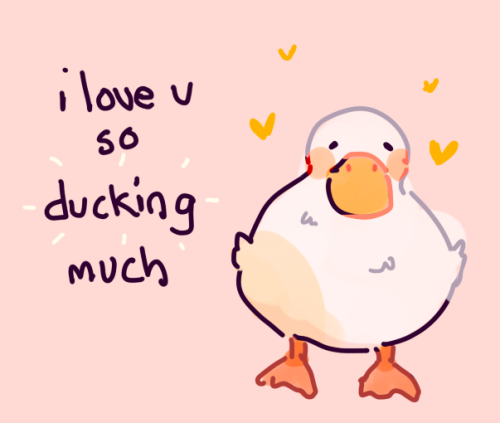
@staff are you fucking kidding me right now?! You’re limiting text posts to 100 text blocks (aka paragraphs). What the absolute fuck.
Since you couldn’t take out fanfic writers with the purge so you’re just fucking up formatting for text posts until they leave? Is that your plan?
(◡‿◡✿)
(ʘ‿ʘ✿) “what you say ‘bout me”
(ʘ‿ʘ)ノ✿ “hold my flower”
Please reply to this post/message me if you RP the game Watch_Dogs! I'm currently playing through the first game (Currently on the last mission of Act 2), and I just created an OC that I'd love to RP using. :)
Reblog if you think Aiden Pearce deserves to be happy
I do. I think he deserves it. Like really.
Writing Traumatic Injuries References
So, pretty frequently writers screw up when they write about injuries. People are clonked over the head, pass out for hours, and wake up with just a headache… Eragon breaks his wrist and it’s just fine within days… Wounds heal with nary a scar, ever…
I’m aiming to fix that.
Here are over 100 links covering just about every facet of traumatic injuries (physical, psychological, long-term), focusing mainly on burns, concussions, fractures, and lacerations. Now you can beat up your characters properly!
General resources
WebMD
Mayo Clinic first aid
Mayo Clinic diseases
First Aid
PubMed: The source for biomedical literature
Diagrams: Veins (towards heart), arteries (away from heart) bones, nervous system, brain
Burns
General overview: Includes degrees
Burn severity: Including how to estimate body area affected
Burn treatment: 1st, 2nd, and 3rd degrees
Smoke inhalation
Smoke inhalation treatment
Chemical burns
Hot tar burns
Sunburns
Incisions and Lacerations
Essentials of skin laceration repair (including stitching techniques)
When to stitch (Journal article–Doctors apparently usually go by experience on this)
More about when to stitch (Simple guide for moms)
Basic wound treatment
Incision vs. laceration: Most of the time (including in medical literature) they’re used synonymously, but eh.
Types of lacerations: Page has links to some particularly graphic images–beware!
How to stop bleeding: 1, 2, 3
Puncture wounds: Including a bit about what sort of wounds are most likely to become infected
More about puncture wounds
Wound assessment: A huge amount of information, including what the color of the flesh indicates, different kinds of things that ooze from a wound, and so much more.
Home treatment of gunshot wound, also basics More about gunshot wounds, including medical procedures
Tourniquet use: Controversy around it, latest research
Location pain chart: Originally intended for tattoo pain, but pretty accurate for cuts
General note: Deeper=more serious. Elevate wounded limb so that gravity draws blood towards heart. Scalp wounds also bleed a lot but tend to be superficial. If it’s dirty, risk infection. If it hits the digestive system and you don’t die immediately, infection’ll probably kill you. Don’t forget the possibility of tetanus! If a wound is positioned such that movement would cause the wound to gape open (i.e. horizontally across the knee) it’s harder to keep it closed and may take longer for it to heal.
Broken bones
Types of fractures
Setting a broken bone when no doctor is available
Healing time of common fractures
Broken wrists
Broken ankles/feet
Fractured vertebrae: Neck (1, 2), back
Types of casts
Splints
Fracture complications
Broken noses
Broken digits: Fingers and toes
General notes: If it’s a compound fracture (bone poking through) good luck fixing it on your own. If the bone is in multiple pieces, surgery is necessary to fix it–probably can’t reduce (“set”) it from the outside. Older people heal more slowly. It’s possible for bones to “heal” crooked and cause long-term problems and joint pain. Consider damage to nearby nerves, muscle, and blood vessels.
Concussions
General overview
Types of concussions 1, 2
Concussion complications
Mild Brain Injuries: The next step up from most severe type of concussion, Grade 3
Post-concussion syndrome
Second impact syndrome: When a second blow delivered before recovering from the initial concussion has catastrophic effects. Apparently rare.
Recovering from a concussion
Symptoms: Scroll about halfway down the page for the most severe symptoms
Whiplash
General notes: If you pass out, even for a few seconds, it’s serious. If you have multiple concussions over a lifetime, they will be progressively more serious. Symptoms can linger for a long time.
Character reaction:
Shock (general)
Physical shock: 1, 2
Fight-or-flight response: 1, 2
Long-term emotional trauma: 1 (Includes symptoms), 2
First aid for emotional trauma
Treatment (drugs)
WebMD painkiller guide
Treatment (herbs)
1, 2, 3, 4
Miscellany
Snake bites: No, you don’t suck the venom out or apply tourniquettes
Frostbite
Frostbite treatment
Severe frostbite treatment
When frostbite sets in: A handy chart for how long your characters have outside at various temperatures and wind speeds before they get frostbitten
First aid myths: 1, 2, 3, 4, 5 Includes the ones about buttering burns and putting snow on frostbite.
Poisons: Why inducing vomiting is a bad idea
Poisonous plants
Dislocations: Symptoms 1, 2; treatment. General notes: Repeated dislocations of same joint may lead to permanent tissue damage and may cause or be symptomatic of weakened ligaments. Docs recommend against trying to reduce (put back) dislocated joint on your own, though information about how to do it is easily found online.
Muscular strains
Joint sprain
Resuscitation after near-drowning: 1, 2
Current CPR practices: We don’t do mouth-to-mouth anymore.
The DSM IV, for all your mental illness needs.
Electrical shock
Human response to electrical shock: Includes handy-dandy voltage chart
Length of contact needed at different voltages to cause injury
Evaluation protocol for electric shock injury
Neurological complications
Electrical and lightning injury
Cardiac complications
Delayed effects and a good general summary
Acquired savant syndrome: Brain injuries (including a lightning strike) triggering development of amazing artistic and other abilities
Please don’t repost! You can find the original document (also created by me) here.

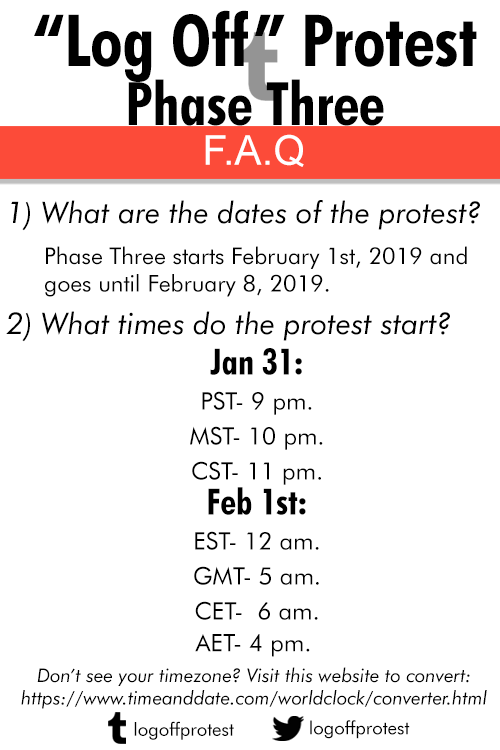
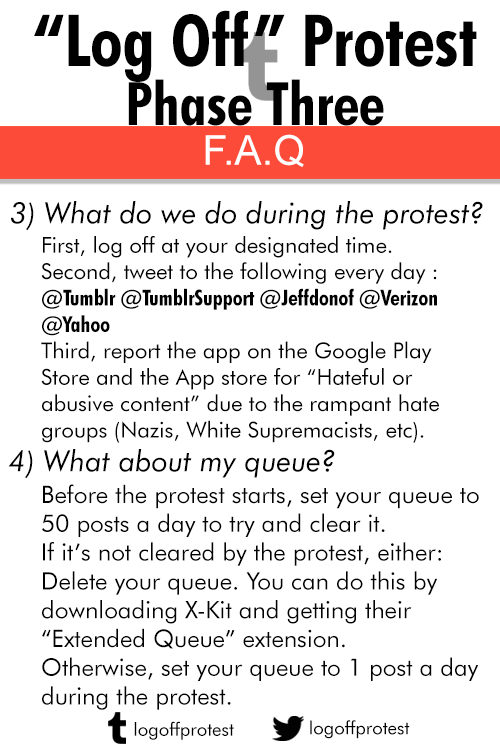
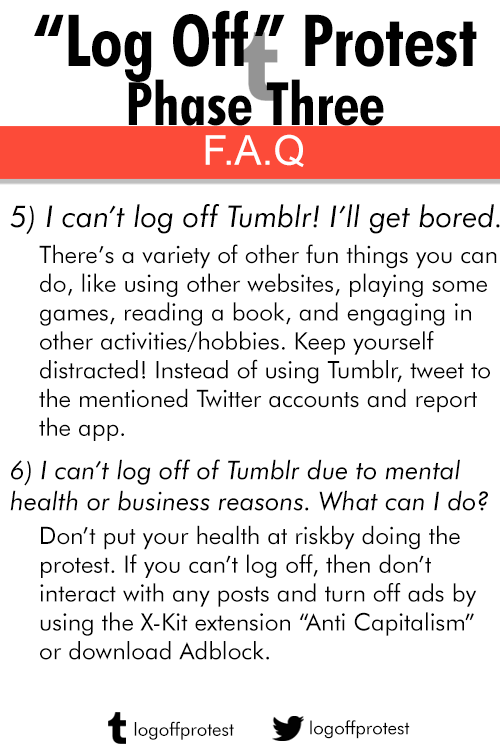
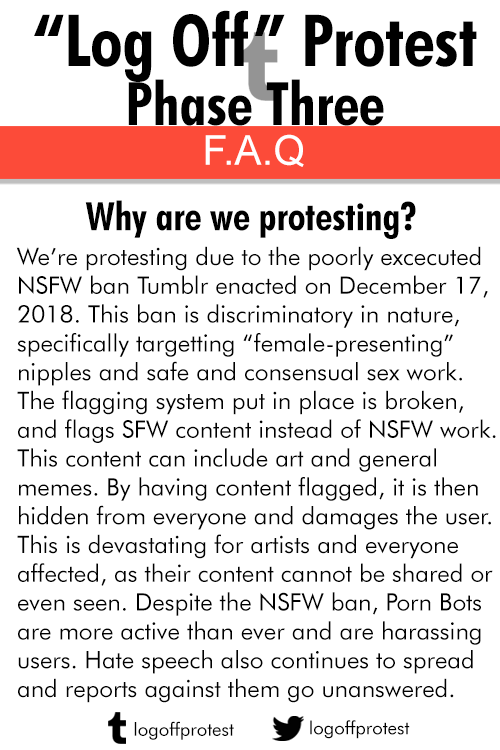
The Official “Phase Three” F.A.Q!
The protest is starting in ONE WEEK on February 1st 12 am est and extends until February 8, 12 am est. I’ve answered the most common questions about the protest above, so make sure to read over everything before sending an ask!
Log off for a week at these dates and times:
Jan 31:
PST- 9 pm.
MST- 10 pm.
CST- 11pm.
Feb 1:
EST-12 am.
GMT- 5 am.
CET- 6 am.
AET- 4 pm.
If you don’t see your timezone, use this link.
On every day from the start of the protest until the end, tweet to the following about why you’re participating in the protest and what you want to be done. Tag each tweet with #phasethree2019.
@tumblr @tumblrsupport @verizon @yahoo @jeffdonof
Also, make sure to report the app on the Google Play Store and the App store for “Hateful or Abusive content” due to the hate groups on here.
Make sure to follow us here, and on Twitter at @logoffprotest ! Thank you for your support.
So, I want to watch the first two Alien movies with some friends who aren’t as used to horror as I am, and I’m looking for some ways to make it less scary. Do the faceless internet strangers of Tumblr have any suggestions?
One of these days I should actually write up, like, “a fannish guide to C-PTSD and BPD” for people who aren’t mental health professionals, so that people understand what I mean when I say a character sets off my trauma radar.
I’m writing that kind of thing for work–trying to explain these disorders to people who have them, since I can write from the perspective of having them, and so much psychological literature is essentially written by therapists as a way of teaching other therapists how to treat people, not about how to live as one of those people. But it’s hard–hard to constantly dig up my perspective and re-root it in a different position, when I’m so used to being clinically detached; hard to concisely explain things that took years of experience to learn.
I struggle also with my position in fandom? I don’t like being in a position of authority over knowledge, telling people what to think and what’s correct or incorrect. Especially in the mental health field, I go out of my way to de-emphasize my systemic power and build up peoples’ knowledge over their own lives. So I don’t want to say, you know, “That neurodivergent headcanon is incorrect!” or anything like that, ever.
On the other hand, I do kind of want to explain the frankly excessive amount of thought that goes into some of my own headcanons, because when people go, “You can’t just slap these labels on characters! You’re not an expert!” I’m like… I can slap these labels on people, not just fictional characters. I can legally diagnose people. I kind of am an expert. So I’m not coming at this from the same place as someone who’s read the Abnormal chapter of their Psychology 101 textbook. XD
And somehow, telling people, “Just read three or four of these books” has a low success rate.

It’s a bit of a throwback, but I thought I’d share these. I made instrumental writing playlists.
Characters Bottling Emotions

@knightedwriter asked: “I have this character who gets into a stressful situation and has a history of emotional abuse. He bottles his emotions. I’m having a lot of trouble figuring out how he should respond to situations, especially as his stress builds and he starts to break. He’s not the POV character.”
I’ve gotten similar questions more than a few times recently and I think there’s something to be said for characters who don’t wear their heart on their sleeves are harder to write about when it comes to showing emotion.
Keep reading
How to write a kickass paper/essay
Because sooner or later, you will have to do it. You won’t get through high school and/or college without doing it. Here’s how to get a good grade on the first try.
1. This isn’t the same thing as writing a story. In fiction writing, bending grammar rules and stuffy writing conventions is okay. In academic writing, it’s not. Get the facts across first and worry about character later. Academic writing is kind of boring, I know. Act like you know what you’re talking about. Don’t abuse the thesaurus until you sound like a post from r/iamverysmart, but try to sound educated.
2. Pick a specific topic. One of my essays from high school was a comparison of youth activism against violence, in the 1960s versus the 2010s. Ridiculously specific? Not ridiculously. If you pick a topic that’s too broad, you’ll end up pulling your brain every which way and overwhelming yourself. You might have some hits and misses with this, but it’s an important part of writing. Going over the word limit is just as annoying to your teacher as going under.
3. MELELEC. My 11th-grade English teacher taught me this little trick and I use it as a mainstay for writing. It’s helped me ace assignments and win scholarships. MELELEC is a paragraph structure that helps you write paragraphs that are not only thicc and will eat up page space, but also are packed with meaningful content. The format is Main Point - Explain - Link - Explain - Link - Explain - Conclusion. You introduce the idea of the paragraph, add some extra information, link a related point or piece of information, explain that, link another point, explain that, and then conclude the idea expressed in the paragraph. It works, I swear. Teachers and professors love it.
4. Absolutely NO second-person. That’s when you directly address the audience as “you.” Yeah, don’t do that if you want to sound professional. I’m doing it right now and sounding hypocritical af because I don’t need to sound professional. It’s Tumblr. Enough said. Anyway, second-person statements tend to have a defensive effect on the audience, which makes them automatically more hostile to whatever you’re trying to say. (”Nuh-uh. I don’t think that. I would do that. That’s not how it works for me.”) And given that the whole point of your essay is to convince your audience that you’re right, that’s counterintuitive. The only time the word “you” should appear in academic writing is when it’s in the context of a quotation.
5. Avoid first-person, too. In some cases, you might need to write an essay in the first person, like when a college prof asks you to write about a personal experience. Yeah, good luck writing about your life without actually mentioning yourself. But in more impersonal writing, like informative or persuasive essays, it looks unprofessional. Sorry, but the audience doesn’t want to hear your take on stuff; they want to know the facts. (Well, if you want to be really specific, they want to hear your take on stuff when it’s expressed as fact and backed up with, ya know, actual facts.) Which leads me into my next point…
6. State opinions as facts. Don’t do this in real life, as it makes you look like a pompous asshole, but do it in academic writing. In other words, never soften a sentence with “I think” or “In my opinion.” Everyone already knows it’s your opinion, anyway. Instead of softening the the blow to lessen the chance of it offending someone, cite some evidence or make another point to back up your claim. That’s substance, which is what your teachers and profs are looking for.
7. The thesis. It’s all about the thesis. The thesis is the TL;DR of your paper. It’s the answer to the question “What’s the doodly-darn point of this essay?” The traditional spot for the thesis statement is the last sentence of the first paragraph – it’s punchy and to the point there. Take time to have a good thesis
8. Don’t ask rhetorical questions. You’re the one who should be answering the questions that your audience has. So predict what they might ask about your topic or the points that you make, and answer them. It’s not the audience’s job to answer your questions, for the love of all things good. You can make them leave thinking about what you wrote without being so anvilicious.
9. Three is the magic number. In high school, the typical format you’ll have for an essay is the five-paragraph format. Now you might be going “Whut? I thought you said that three was the magic number, Saybyebus.” Well, yes, I did say that, but two of the five essays are the introduction and the conclusion. So that leaves you with three paragraphs to really get into the meat of your essay and dish out the important information. So one of the best ways to work with this is to make your thesis three-pronged, and use each of the three paragraphs to address a point of your thesis. Boom-shacka-lacka. I just laid out the structure of your essay. Does that mean you have to cite me as credit? IDK, actually. But that does remind me of my next point…
10. DON’T PLAGIARIZE! Bruh, don’t do it. Whenever you learn something from someone else’s work and add that information to your essay, you have to cite them, even if you paraphrase them. If you don’t do that, it’s plagiarism. In high school, it’ll get you a big-ass downgrade, and you will probably get yelled at by your teacher. In college, it could get you SUSPENDED or EXPELLED. They take that shit seriously. So you should too.
Hello! I was wondering if you had any links or tips for writing characters with distinct regional dialects?
Writing Accents and Dialects
Dialogue in fiction: How to write authentic dialects and foreign accents
How to Write Accents and Dialects
How to Give Your Character an Authentic Dialect
The Do’s and Don’ts of Dialects
Writing Dialogue in Accents and Dialect
The Uses and Abuses of Dialect
Dialogue: Writing Dialects and Accents
When Can You Include an Accent and Dialect in Your Dialogue?
Accents and Dialects
Writing Dialects
How to Write Accents and Dialects
Dialect and Contractions in Fiction
Writing Dialect in Fiction: a History and Study
Effective Dialogue: Accents and Dialects
How to Write Dialects, Accents, and Slang
Talking the Talk: Writing in Dialect

sometimes i wonder how a writer would describe me if i were a character in a book
Trait labels
I made a list of autistic slang terms that included a few alternatives to functioning labels. I call them trait labels. Here’s an updated version of that list:
Ninja- nonverbal (because ninjas are silent)
Camo - able to pass as NS (camo is short for camouflage)
Dragon - one who hordes collects items relating to a special interest
Timekeeper - one with a low IQ (the timekeepers of Ancient Egypt are believed to have been autistic, and while they were severely handicapped in other areas, they were able to maintain the most accurate calendar in the world of that time period)
Echo - one who primarily communicates through echolalia
Turtle - asocial (because a turtle can withdraw into its shell)
These terms can be combined to describe multiple Autistic traits one has. For example, a nonverbal autistic person who is very introverted and asocial is called a Ninja Turtle (yes, I adjusted the list in such a way that this combination would be possible 😝😝😝). To say that you don’t show a certain trait very often, you can add part time before a label. To throw in another grammar rule, make sure part time comes directly before the trait that isn’t very prevalent. For example, part time turtle ninja refers to someone who is only introverted and asocial at times but is always nonverbal, whereas a part time ninja turtle is someone who’s semiverbal and is always asocial.
I’m open to suggestions for more labels.
Ripley: I’ve only had Newt for a day and a half, but if anything happened to her, I would kill everyone in this room and then myself.